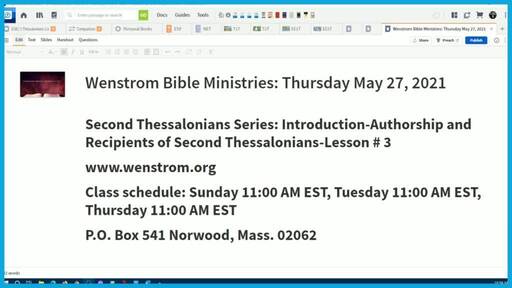Second Thessalonians-Introduction Part 1
Doctrinal Bible Church
Pastor-Teacher Bill Wenstrom
Sunday February 23, 2025
Second Thessalonians Series: Introduction Part 1
Lesson # 1
Second Thessalonians is one of the shortest of the thirteen letters which are traditionally attributed to the apostle Paul since it contains approximately 823 words in the Greek text with only Philemon and Titus being shorter since the former contains 335 words and the latter 659.
Therefore, this epistle has little more than half the words of 1 Thessalonians which contains 1,481 words.
Second Thessalonians was written within six months of First Thessalonians.
Therefore, the former like the latter is one of the earliest epistles the apostle penned since the latter is also considered by many scholars to be written by Paul in approximately 49 A.D.
Consequently, the issues related to the historical background of Second Thessalonians as well as the date, place of origin and recipients of this book are the same as that of First Thessalonians with only a few slight additions.
Like First Thessalonians, the canonicity of Second Thessalonians is supported by the fact that it was included in the earliest collections of New Testament writings which circulated in the early centuries of the church.
Like First Thessalonians, Second Thessalonians is written according to the pattern of letter writing found in the ancient world during the first century called the “epistle.”
Like First Thessalonians, the structure of Second Thessalonians fits the various situations and problems Paul sought to address with the Thessalonian Christian community, which of course, is the case in each of his writings.
Like First Thessalonians, the introduction of Second Thessalonians (1:1-12) follows the normal pattern of greeting and thanksgiving which is also the case with the letter’s conclusion.
The letters opening in verses 1-2 contain the identification of the senders of the letter (1:1a) as well as the identification of the recipients of the letter (1:1b) followed by a greeting (1:2).
This opening is followed by thanksgiving (1:3-12), which records Paul commending the Thessalonians for their spiritual growth (1:3-4).
It also contains the apostle seeking to comfort them as they were experiencing persecution for their faith (1:5-10).
He comforts them by asserting that those who persecute them will be judged by the Lord at His Second Advent.
The opening comes to a close (1:11-12) with Paul communicating to them his Spirit inspired prayer for them.
He asserts that he asked that the Father would make them worthy of His calling and that by His power He would bring to fruition their every desire for goodness and their every deed prompted by their faith in his apostolic teaching.
Therefore, like First Thessalonians, the opening of Second Thessalonians is contained in the first chapter with the body of the letter beginning in chapter two.
In Second Thessalonians, the body of the letter begins with Paul again as he did in First Thessalonians addressing the Thessalonians relationship to the eschatological day of the Lord, which is composed of the seventieth week of Daniel and Jesus Christ’s subsequent Second Advent.
Specifically, the apostle addresses a crisis in the church since it appears that some false teachers were teaching the Thessalonians that this eschatological day of the Lord had arrived.
Paul instructs the Thessalonians that they must not become so easily unsettled or alarmed by this teaching whether allegedly by him, Silvanus and Timothy or whether by some prophetic utterance (2:1-2).
Then, in verses 3-4, Paul teaches the Thessalonians that the day of the Lord will not arrive until the rebellion led by Antichrist takes place during the seventieth week of Daniel and will not take place until Antichrist has been revealed.
He describes the Antichrist as well.
In verses 5-8, the apostle reminds them what he taught them while he was with them, namely that the restrainer was holding back the manifestation of the Antichrist to the world and that will not be revealed until the restrainer is taken out of the way.
This is a reference to the Holy Spirit being removed from the earth at the rapture of the church since He indwells each member of the body of Christ.
Verses 9-11 serves to further describe the Antichrist’s actions during the seventieth week of Daniel.
After this instruction on the day of the Lord, Paul breaks into thanksgiving again for the Thessalonians and then presents the reason why he thanked the Father for them in prayer (2:13-14).
The apostle then presents the inference from this reason why he thanked the Father in prayer for them which is that they continue to obey his apostolic teaching (2:15).
He then communicates to them the contents of his Spirit inspired prayer request for them that their hearts would be encouraged and strengthened in every good deed and word (2:16).
The next major section of the body of Second Thessalonians appears in 2 Thessalonians 3:1-5, which contains Paul requesting that the Thessalonians intercede in prayer for him, Silvanus and Timothy that the message of the gospel would spread rapidly and be honored as it was with them.
He also requests that they intercede in prayer for him, Silvanus and Timothy that they might be delivered from wicked and evil people who oppose the gospel (3:2).
He comforts them by asserting that the Lord is faithful and will strengthen them and protect them from the evil one (3:3).
Paul also asserts his belief that the Thessalonians would continue to obey his apostolic teaching (3:4).
Lastly, he communicates another prayer that he offered up to the Father for them, namely, that the Lord would continue to direct their hearts into practicing the love of God in their lives with each other and all people as well as Christ’s perseverance.
Then, the final major section of the body of Second Thessalonians appears in 2 Thessalonians 3:6-15.
In this section, the apostle Paul then addresses another major problem, namely that some in the Thessalonian Christian community were reverting back to their pre-justification days when they did not work.
He exhorts them to practice church discipline with these individuals (3:6).
Paul then reminds them that he, Silvanus and Timothy taught them that they must work for a living and that they gave them an example to follow in doing so (3:7-10).
He then informs them that he and Silvanus heard from Timothy more than likely that some of them were idle and disruptive and were not busy working but rather being busy bodies (3:11).
He then commands them to work for a living and never tire of practicing divine good, which is accomplished by obeying Paul’s apostolic teaching (3:12-13).
Paul closes this section with an injunction to again practice church discipline with those who are unwilling to work in obedience to his teaching (3:14).
2 Thessalonians 3:16-18 contains the conclusion to the letter.
In this section, Paul again presents to the Thessalonians another one of his Spirit inspired prayer requests that he offered up to the Father in prayer for them (3:16).
Namely, Paul prayer that the Lord who produces peace in and among them would Himself give them peace at all times.
He also requested that the Father would be with them.
Then, in verse 17, the apostle Paul asserts that this conclusion is signed personally by himself with the distinguishing marks he used in all his letters to protect against counterfeiters.
Verse 18 contains a grace benediction.





